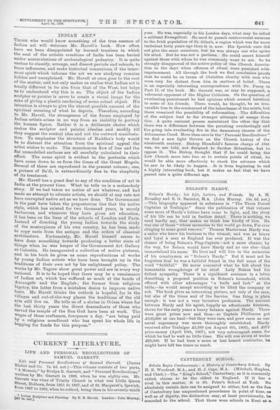INDIAN ART.* THOSE who would know something of the true
essence of Indian art will *elcome Mr. Havell'a book. How often have we been disappointed by learned treatises in which the soul of the artistic creations of India has been buried under accumulations of archaeological pedantry. It is quite useless to classify, arrange, and dissect periods and schools, to trace influences, and make historical connexions, if the inner- most spirit which informs the art we are studying remains hidden and unexplained. Mr. Havell at once goes to the root of the matter, and not only makes us realise that Indian art is totally different in its aim from that of the West, but helps us to understand why this is so. The object of the Indian
sculptor or painter is never to create a visual image for the sake of giving a plastio rendering of some actual object. His Intention is always to give the utmost possible amount of the spiritual meaning of what he depicts. Therefore, according to Mr. Havell, the strangeness of the forms employed by Indian artists arises in no way from an inability to portray the human figure. Rather it is a deliberate choice which makes the sculptor and painter idealise and modify till they suggest the central idea and not the outward manifesta- tion. To emphasise the structure of Buddha's body would be to distract the attention from the spiritual appeal the artist wishes to make. The monotonous flow of line and the flat unmodelled surfaces are all carefully calculated in their effect. The same spirit is evident in the portraits which have come down to us from the times of the Great Moguls. Several of these are reproduced in the present volume ; one, a, picture of Sa'di, is extraordinarily fine in the simplicity Of its treatment.
Mr. Havell has a great deal to say of the condition of art in India at the present time. What he tells us is a melancholy story. If we had taken no notice of art whatever, and had made no attempt to educate artists, we should at any rate not have corrupted native art as we have done. The Government in the past have taken the preposterous line that the native style, which has existed for two thousand years, is merely barbarous, and whenever they have given art education, it has been on the lines of the schools of London and Paris. Instead of directing the young Indian towards the study of the masterpieces of his own country, he has been made to copy casts from the antique and the orders of classical architecture. Fortunately, Mr. Havell himself seems to have done something towards producing a better state of things when he was keeper of the Government Art Gallery at Calcutta. He inaugurated a collection of native pictures, and in his book he gives us some reproductions of works by young Indian artists who have been brought up in the traditions of their own art by his enlightened policy. The works by Mr. Tagore show great power and are in every way national. It is to be hoped that there may be a renaissance of Indian art, which has suffered so much at the hands of Aurangelb and the English ; the former from religious bigotry, the latter from a mistaken desire to improve native taste. Mr. Havel' thinks the outlook is hopeful, for in the villages and out-of-the-way places the traditions of the old arta still live on. He tells us of a shrine in Orissa where for the last thirty years the direct descendants of those who carved the temple of the Sun God have been at work. The Wages of these craftsmen, fonrpence a day, "are being paid by a religious mendicant who has spent his whole life in begging for funds for this purpose."






















































 Previous page
Previous page